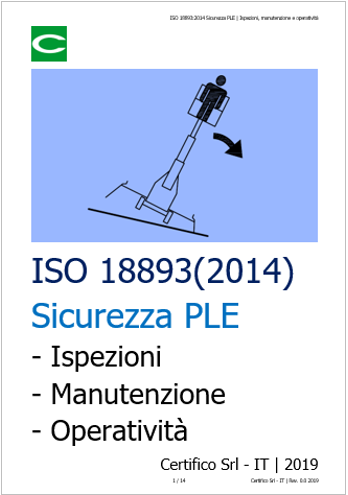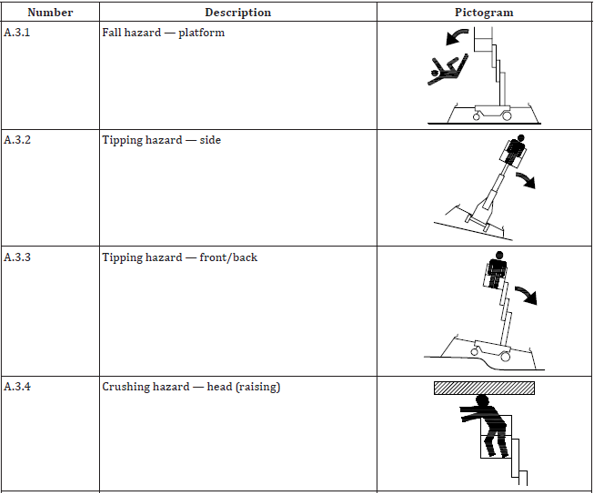
ISO 18893:2014
Sicurezza PLE | Ispezioni, manutenzione e operatività
ID 8613 | 23.06.2019
Controlli sicurezza PLE secondo la Norma ISO 18893:2014
In allegato Documento completo estratto dalla norma ISO 18893:2014 di riferimento per i controlli da effettuare per l’uso delle PLE. In particolare sono riportate le indicazioni di cui al Cap 6 con le quali è possibile generare check di controllo.
Evidenziati nel documento i Pittogrammi di uso improprio delle PLE (secondo il tipo) riportati nell’Allegato A della Norma.
_______
Con la pubblicazione della norma ISO 18893:2014 (in lingua inglese) è stata ritirata dal corpo normativo nazionale la norma UNI ISO 18893:2011 - Piattaforme di lavoro mobili elevabili - Principi di sicurezza, ispezione, manutenzione e funzionamento, in quanto superata, in attesa della traduzione/armonizzazione della nuova edizione della norma.
Gli obiettivi che si pone la norma sono:
a) prevenzione di lesioni personali, danni a proprietà e incidenti;
b) definizione di criteri per l’ispezione, la manutenzione e l’azionamento.
Tra i principi di base della norma vi è l’indicazione che le informazioni contenute devono essere completate da una buona gestione del lavoro, dal controllo sulla sicurezza e dall’applicazione di sani principi di sicurezza, addestramento, ispezione, manutenzione, applicazione e funzionamento. Devono essere considerati tutti i dati disponibili relativamente ai parametri dell’uso previsto e dell’ambiente previsto.
Coloro che hanno il controllo diretto sull’applicazione e sul funzionamento delle PLE devono essere responsabili della conformità alle buone prassi per la sicurezza.
Le decisioni sull’uso e sul funzionamento delle PLE devono essere sempre prese con debita considerazione per il fatto che la macchina trasporterà persone la cui sicurezza dipende da tali decisioni.
Riguardo alla manutenzione la norma prevede che sia stabilito un programma di manutenzione preventiva in conformità alle raccomandazioni del fabbricante e in base all’ambiente e alla gravosità di utilizzo della PLE.
La frequenza di ispezione e manutenzione deve essere compatibile con le condizioni operative e la gravosità dell’ambiente di utilizzo.
Le PLE che non sono in condizioni operative appropriate devono essere riparate da una persona qualificata e le riparazioni devono avvenire in conformità alle raccomandazioni del fabbricante.
La norma prevede anche che se una macchina è fuori servizio da un periodo maggiore di tre mesi sia sottoposta ad un’ispezione effettuata da una persona qualificata per la marca e il modello prima di rimetterla in servizio.
La stessa norma prevede (come previsto anche da tutti i manuali dei fabbricanti), che ogni giorno prima dell’uso o all’inizio di ogni turno, la PLE sia sottoposta a un’ispezione visiva ed una prova funzionale che può effettuare l’operatore stesso.
Riguardo sempre alla manutenzione la norma indica delle precauzioni di sicurezza per la manutenzione e la riparazione e prevede che il personale di manutenzione sia addestrato da una persona qualificata.
Altri elementi importanti riguardano le parti di ricambio che devono essere identiche o equivalenti alla parti o ai componenti originali e l’obbligo di rispettare eventuali bollettini relativi alla sicurezza forniti dal costruttore.
______
ISO 18893:2014
La parte 6 della Norma tratta dell’Uso in sicurezza della PLE durante la sua operatività:
6 Operation
6.1 Planning
6.1.1 General
The extent of the planning required depends on the nature of the task to be carried out and the hazards associated with it but the following planning steps shall be taken. Planning shall be the responsibility of the entity that has care and custody of the MEWP. It is the employer’s or user’s responsibility to make
sure the planning is carried out with the operator.
6.1.2 Stages of planning
6.1.2.1 Communicate the plan to all persons involved
One of the most important aspects of successful planning is to ensure that the contents of the plan are communicated effectively to the parties involved, taking into account language differences. Review the plan before the job starts.
Immediately before a job starts and periodically throughout a long-term job, the plan shall be reviewed to check if any parts of the task or the working environment has changed and the effect that could have on the safety of the operation. If any modifications to the plan are required, these should be communicated to all those involved.
6.1.2.2 Identify the task to be undertaken
As the first stage in the planning process, the task to be undertaken should be clearly identified, together with the location and timing.
6.1.2.3 Select an appropriate MEWP
There are many different types of MEWPs with various rated capacities, working heights, and reaches.
The correct machine should be selected for the task to be undertaken, taking into account the constraints of the work site, ground conditions, site access, and proximity to the public or other workers.
If the area in which the MEWP is to be working is a hazardous environment (see 6.7), a MEWP designed/designated for this environment shall be selected.
6.1.2.4 Assessment of the risks associated with the task
Assessment of the risks associated with the task shall be identified. These might be associated with the location where the work is to be carried out, the nature of the MEWP or the personnel, and materials and equipment to be carried.
6.1.2.5 Identify control measures
Once the hazards and the risks involved in the task have been identified, the procedures and measures required to control them shall be identified.
6.1.2.6 Develop the method to be used
Having identified the hazards, evaluated the risks, and worked out the control measures required to carry out the task safely, a selection of the method from the control measures shall be developed into a plan that will be communicated and implemented. The plan shall include any contingency measures and rescue procedures.
...
6.2 Operator training
The employer shall ensure that the operator has been trained under the direction of a qualified person in accordance with ISO 18878 and this International Standard before operating the MEWP.
6.3 Familiarization
It is the employer’s or user’s responsibility to make sure the operator is familiarized with the location and presence of the machine operations manual, purpose and function of the platform and ground controls, and the safety features and operating characteristics of each model of MEWP they are authorized to Before operating the controls of a MEWP, the operator shall check that they know the position, function, and correct operation of both the emergency/auxiliary lowering controls and the emergency stop switch. Emergency controls shall not be used for purposes other than lowering the work platform in an emergency.
...
6.5 Before operation
Safe operation of a MEWP requires the following:
a) understanding of the task to be performed;
b) selection of a MEWP appropriate for the task to be performed;
c) knowledge of the intended purpose and function of each control;
d) authorization by the employer;
e) that stabilizers, such as outriggers, extendible axles, or other stability-enhancing means, are used as required by the manufacturer;
f) that guardrails are installed and access gates or openings are closed or in appropriate positions per manufacturer’s instructions;
g) that loads and their distribution on the work platform and any platform extension are in accordance with the manufacturer’s rated load for that specific configuration;
h) understanding of the manufacturer’s operating instruction(s) and user safety rules, or having them explained by a qualified person;
i) understanding by reading or by having a qualified person explain all decals, warnings, and instructions displayed on the MEWP;
j) use of appropriate personal protective equipment for the conditions, including the environment in which the MEWP will be operated; and
k) ensuring that another responsible person is on the job site, who is not working on the platform, and knows how to use the emergency controls.
...
6.6 Work place inspection
...
6.7 Understanding of hazardous locations
...
6.8 Specific requirements of operation
...
L’Appendice A1 elenca i Pittogrammi di uso improprio di una PLE/MEWP (secondo il tipo)
Tabella A.1 - Esempi di uso improprio MEWP a forbice
Tabella A.2 - Esempi di uso improprio MEWP a braccio
Tabella A.3 - Esempi di uso improprio del MEWP verticale
Tabella A.4 - Esempi di uso improprio del MEWP montato sul veicolo
Annex A (informative) Pictograms of MEWP misuse
A.1 Misuse of scissor-type MEWPs
Pictograms of the misuse of scissor-type MEWPs are shown in Table A.1.
Table A.1 - Examples of scissor type MEWP misuse

...
A.2 Misuse of boom-type MEWPs
Pictograms of the misuse of boom-type MEWPs are shown in Table A.2.
Table A.2 - Examples of boom-type MEWP misuse

...
A.3 Misuse of vertical mast type MEWPs
The pictograms of the misuse of vertical mast type MEWPs are shown in Table A.3.
Table A.3 - Examples of vertical mast type MEWP misuse

A.4 Misuse of vehicle-mounted MEWPs
Pictograms of the misuse of vehicle-mounted MEWPs are shown in Table A.4.
Table A.4 - Examples of vehicle-mounted MEWP misuse
...
segue in allegato
ISO 18893:2014
Mobile elevating work platforms - Safety principles, inspection, maintenance and operation (MEWP)
Certifico Srl - IT | Rev. 0.0 2019
©Copia autorizzata Abbonati
ISO Licensed Certifico Srl
Info e download
Collegati
PLE nei cantieri
D.Lgs. 81/2008 Testo Unico Salute e Sicurezza Lavoro








































